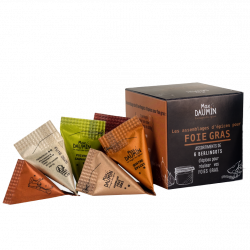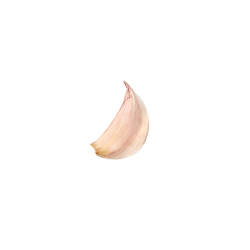Coffret Assemblage Foie Gras
Fabien Pairon, MOF Charcutier Traiteur and Max have developed an assortment of 6 berlingots of different spices to make your foie gras.
You will have classic mixtures for a foie gras with Four-spice or with our special foie gras assembly, or even Voatsiperifery pepper which will surprise you. More surprising, a foie gras with Vanilla or a subtle blend of Jamaica Pepper and Tonka. But also for an “off the beaten track” version, the Timur-Sichuan blend!
We wish you great achievements and sharing beautiful gourmet slices of life!
-
Net weight : 10g
-
Composition : 1 carton of Allspice, 1 carton of Foie-Gras Assembly, 1 carton of Voatsiperifery, 1 carton of Vanilla, 1 carton of Tonka-Allspice Pepper, 1 carton of Timur-Sichuan + recipe inside
-
Dimensions :
-
Recyclable box and berlingots : Sorting paper / cardboard



Benefits
Cooking and Virtue
- A liver lobe raw deveined fat of 500g
- 7g salt
- 2g sugar< /span>
- 25g of alcohol (for an aperitif wine) - or 15g (for a strong alcohol) Noilly Prat (vermouth) is a particularly recommended aperitif wine, it highlights your foie gras and your spices. For the foie gras blend, you may prefer a more robust alcohol such as port, cognac or Armagnac < span style="font-family: Arial, sans-serif;">
- 1 carton (the one of your choice)
Pour from a bowl: the alcohol, salt, sugar and the contents of the carton. Mix well.
Dismantle your foie gras into pieces (approximately 3cmx3cm). Add the contents of the bowl. Mix well to allow the mixture of spices and alcohol to penetrate. Cover everything and leave to marinate overnight in the refrigerator.
The next day, cook your foie gras in a bain-marie in a terrine at 110 degrees for 40 minutes. The ideal is to have core cooking at 56 degrees.
Let cool overnight; with a little press on top if possible.
Have a good tasting!
Your foie gras will then keep in the refrigerator for around ten days.

Origins
A long journey
The production of Foie Gras is a centuries-old tradition whose origins date back more than 4,500 years. A fresco discovered in an ancient Egyptian tomb showing a slave feeding a goose with figs testifies to these distant roots (Saqqara necropolis).
This production was widespread in particular by the Jewish people who, during their exodus, fattened geese to produce fat to replace lard (considered unfit for human consumption).
Foie gras was first served as a Roman meal in the 1st century BC, during a sumptuous banquet recounted by Horace. The Roman craze for liver fattened with figs reached such heights that from the 4th century, “ficatum” (“with figs”) became the term used to describe the liver of all fattened animals. It will give rise to the French anatomical term “Liver” several centuries later.
It was during Roman times that Foie Gras was first consumed in “Provincia” before spreading to other regions of Roman Gaul, notably in the south-west of France. Many different peoples within the Roman Empire, including the Gallo-Romans, became experts in preparing foie gras. Subsequently, the fattened animals and their livers were consumed in different preparations throughout the Middle Ages. Many regional languages at this time used terms synonymous with force-feeding. In the 15th century, corn, particularly suitable for feeding geese and ducks, was brought from the New World by Christopher Columbus and was soon cultivated throughout the region.
In the 17th and 18th centuries, fattened waterflies were part of the basic diet of peasants. Cooking and preserving livers and meats in fat made it possible to build up reserves, a major advantage when the modern freezer was still a long way off! Paradoxically, foie gras was also served to kings and nobles in pre-revolutionary France.
In the 19th century, the development of canning processes led to the proliferation of canneries which exported Foie Gras throughout the world where it would soon become the standard-bearer of French gastronomy. Since then, Foie Gras has been an integral part of France's culinary and cultural heritage.


Frequently asked questions

3 other products in the same category:

Customers who bought this product also bought:



































